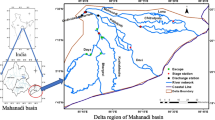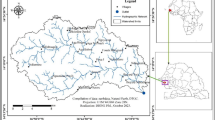Abstract
River flooding has been causing extensive losses to life and property, which is a serious concern worldwide. To minimize these losses, suitable planning and management practices are required for the floodplain map**. Flash floods occur almost every year in the deltaic region of Brahmani and Baitarani river basins in India, during the monsoon season. Generally, 1D modelling is considered as a regular practice. But nowadays, model formulations include 1D for the representation of river channels and 2D for representing river floodplains. In the absence of uniform observations, a hybrid model (1D–2D coupled model) has been developed for this deltaic region to identify the extent of inundation and its depth during the flooding, since 1D models alone do not provide detailed information of flooding. Thus, a well-known 2D river hydrodynamic model iRIC was externally coupled with 1D (SWAT and SWMM) models to simulate and visualize flood scenarios and to identify the flood-prone areas. The hydrological model SWAT was calibrated and validated for Brahmani river deltaic basin, with the observed discharge data available. However for Baitarani river basin, observed flow data were missing and only gauge data were available at few monitoring stations. Hence, for Baitarani river basin, the SWMM model was developed and calibrated with the help of Monte Carlo method. Finally, the SWAT- and SWMM-based tributary stream flow outputs were fed together into the iRIC hydrodynamic model as input for flood inundation map**. The discharge and water gauge data were used for the calibration and validation. The results obtained from the coupled model were found to be in good agreement with the observed data (RMSE value is 0.77 and 0.79 during calibration and validation, respectively), which enabled identification of the flood-prone areas. The developed model may be used as a tool for effective planning and management of natural disasters such as flash floods.








Similar content being viewed by others
References
Abbaspour KC, Johnson CA, Van Genuchten MT (2004) Estimating uncertain flow and transport parameters using a sequential uncertainty fitting procedure. Vadose Zone J 3(4):1340–1352
Abbaspour KC, Yang J, Maximov I, Siber R, Bogner K, Mieleitner J, Srinivasan R (2007) Modelling hydrology and water quality in the pre-alpine/alpine Thur watershed using SWAT. J Hydrol 333(2–4):413–430
Abe T, Yoshikawa Y, Satoh Y, Itoh A (2013) A study on tsunami wave oscillation and ice break-up characteristics in a semi-closed water area in cold region. J Jpn Soc Civil Eng 69(2):455–460. https://doi.org/10.2208/jscejoe.69.455
Ali M, Hasan M, Haque M (2017) Two-dimensional simulation of flows in an open channel with groin-like structures by iRIC Nays2DH. Math Probl Eng 2017:1–10. https://doi.org/10.1155/2017/1275498
Arnold JG, Srinivasan R, Muttiah RS, Williams JR (1998) Large area hydrologic modelling and assessment part I: model development. J Am Water Resour As 34(1):73–89
Bates PD, Dawson RJ, Hall JW, Horritt MS, Nicholls RJ, Wicks J, Hassan MA (2005) Simplified two-dimensional numerical modelling of coastal flooding and example applications. Coast Eng 52(9):793–810
Betsholtz A, Nordlöf B (2017) Potentials and limitations of 1D, 2D and coupled 1D–2D flood modelling in HEC-RAS. TVVR 17/5003
Chai T, Draxler RR (2014) Root mean square error (RMSE) or mean absolute error (MAE)? Arguments against avoiding RMSE in the literature. Geosci Model Dev 7(3):1247–1250
Chaplot V (2005) Impact of DEM mesh size and soil map scale on SWAT runoff, sediment, and NO3–N loads predictions. J Hydrol 312(1–4):207–222
Chow VT (1959) Open channel hydraulics. McGraw-Hill Book Company, New York
Chu TW, Shirmohammadi A (2004) Evaluation of the SWAT model’s hydrology component in the piedmont physiographic region of Maryland. Trans ASAE 47(4):1057
Donigian AS, Yo TR, Shanahan EW (1983) Rapid assessment of potential ground-water contamination under emergency response conditions. Office of Health and Environmental Assessment, Office of Research and Development, US Environmental Protection Agency
Dwarkin J (1976) Global trends in natural disasters, 1947–1973 (Natural Hazard Research Working Paper 26). Boulder: Institute of Behavioral Science, University of Colorado
Glickmen TS, Godling D, Silverman ED (1992) Acts of God and acts of man: recent trends in natural disaster and major industrial accidents (Discussion Paper 92-02). Washington, DC: Resources for the Future, Center for Risk Management
Gupta HV, Sorooshian S, Yapo PO (1999) Status of automatic calibration for hydrologic models: comparison with multilevel expert calibration. J Hydrol Eng 4(2):135–143
Huber WC, Dickinson RE, Barnwell TO (1992) SWMM4 user’s manual. Technical report. EPA
Islam A, Sikka AK, Saha B, Singh A (2012) Streamflow response to climate change in the Brahmani River Basin, India. Water Resour Manag 26(6):1409–1424
Jang CL, Shimizu Y (2005) Numerical simulation of relatively wide, shallow channels with erodible banks. J Hydraul Eng 131(7):565–575
Jang S, Cho M, Yoon J, Yoon Y, Kim S, Kim G, Kim L, Aksoy H (2007) Using SWMM as a tool for hydrologic impact assessment. Desalination 212(1–3):344–356
Kim H, Jung M, Mallari KJ, Pak G, Kim S, Kim S, Kim L, Yoon J (2015) Assessment of porous pavement effectiveness on runoff reduction under climate change scenarios. Desalin Water Treat 53(11):3142–3147
Kirsch I, Moore TJ, Scoboria A, Nicholls SS (2002) The emperor’s new drugs: an analysis of antidepressant medication data submitted to the US Food and Drug Administration. Prev Treat 5(1):23a
Lecce SA (1997) Spatial patterns of historical overbank sedimentation and floodplain evolution, Blue River, Wisconsin. Geomorphology 18(3):265–277
Morales-Hernández M, Petaccia G, Brufau P, García-Navarro P (2016) Conservative 1D–2D coupled numerical strategies applied to river flooding: the Tiber (Rome). Appl Math Model 40(3):2087–2105
Moriasi DN, Arnold JG, Van Liew MW, Bingner RL, Harmel RD, Veith TL (2007) Model evaluation guidelines for systematic quantification of accuracy in watershed simulations. Trans ASABE 50(3):885–900
Nash JE, Sutcliffe JV (1970) River flow forecasting through conceptual models part I—a discussion of principles. J Hydrol 10(3):282–290
Neitsch SL, Arnold JG, Kiniry JEA, Srinivasan R, Williams JR (2002) Soil and water assessment tool user’s manual version 2000. GSWRL report 202(02-06)
Nelson JM, Shimizu Y, Abe T, Asahi K, Gamou M, Inoue T, Iwasaki T, Kakinuma T, Kawamura S, Kimura I, Kyuka T (2016) The international river interface cooperative: public domain flow and morphodynamics software for education and applications. Adv Water Resour 93:62–74
Operational Research to Support Mainstreaming of Integrated Flood Management under Climate Change in India, Interim Report on Policy and Advisory Technical Assistance 8089 IND Phase II for Ministry of Water Resources Government of India, Deltares in association with RMSI and JPS, May 2015
Pappenberger F, Beven K, Horritt M, Blazkova S (2005) Uncertainty in the calibration of effective roughness parameters in HEC-RAS using inundation and downstream level observations. J Hydrol 302(1):46–69
Parajuli PB, Nelson NO, Frees LD, Mankin KR (2009) Comparison of AnnAGNPS and SWAT model simulation results in USDA-CEAP agricultural watersheds in south-central Kansas. Hydrol Process 23(5):748–763
Parker DJ (2000) Floods, vol 1. Routledge Taylor & Francis Group, London
Popescu I, Jonoski A, Van Andel SJ, Onyari E, Moya Quiroga VG (2010) Integrated modelling for flood risk mitigation in Romania: case study of the Timis-Bega river basin. Int J River Basin Manag 8(3–4):269–280
Pramanik N, Panda RK, Sen D (2010) One dimensional hydrodynamic modelling of river flow using DEM extracted river cross-sections. Water Resour Manag 24(5):835–852
Rai PK, Chahar BR, Dhanya CT (2017a) GIS-based SWMM model for simulating the catchment response to flood events. Hydrol Res 48(2):384–394
Rai PK, Dhanya CT, Chahar BR (2017b) Flood control in an urban drainage system using a linear controller. Water Pract Technol 12(4):942–952
Rossman LA (2010) Storm water management model user’s manual, version 5.0. Cincinnati: National Risk Management Research Laboratory, Office of Research and Development, US Environmental Protection Agency
Saleh A, Arnold JG, Gassman PW, Hauck LM, Rosenthal WD, Williams JR, McFarland AM (2000) Application of SWAT for the upper North Bosque River watershed. Trans ASAE 43(5):1077
Santhi C, Arnold JG, Williams JR, Dugas WA, Srinivasan R, Hauck LM (2001) Validation of the SWAT model on a large river basin with point and nonpoint sources. J Am Water Resour As 37(5):1169–1188
Schmalz B, Tavares F, Fohrer N (2008) Modelling hydrological processes in mesoscale lowland river basins with SWAT capabilities and challenges. Hydrol Sci J 53(5):989–1000
Shokory JAN, Tsutsumi JIG, Sakai K (2016) Flood modeling and simulation using iRIC: a case study of Kabul City. In: E3S web of conferences, vol 7. EDP Sciences, p. 04003
Singh J, Knapp HV, Demissie M (2004) Hydrologic modeling of the Iroquois River watershed using HSPF and SWAT. ISWS CR 2004-08. Illinois State Water Survey, Champaign
Singh J, Knapp HV, Arnold JG, Demissie M (2005) Hydrological modeling of the Iroquois River watershed using HSPF and SWAT. J Am Water Resour As 41(2):343–360
Sloan PG, Morre ID, Coltharp GB, Eigel JD (1983) Modelling surface and subsurface stormflow on steeply-slo** forested watersheds. Water Resources Institute Report 142, University of Kentucky, Lexington, Kentucky
Song S, Schmalz B, Fohrer N (2015) Simulation, quantification and comparison of in-channel and floodplain sediment processes in a lowland area—a case study of the Upper Stör catchment in northern Germany. Ecol Ind 57:118–127
Spaliviero M (2003) Historic fluvial development of the Alpine-foreland Tagliamento River, Italy, and consequences for floodplain management. Geomorphology 52(3):317–333
Spruill CA, Workman SR, Taraba JL (2000) Simulation of daily and monthly stream discharge from small watersheds using the SWAT model. Trans ASAE 43(6):1431
Talebizadeh M, Morid S, Ayyoubzadeh SA, Ghasemzadeh M (2010) Uncertainty analysis in sediment load modelling using ANN and SWAT model. Water Resour Manag 24(9):1747–1761
Timbadiya PV, Patel PL, Porey PD (2014) A 1D–2D coupled hydrodynamic model for river flood prediction in a coastal urban floodplain. J Hydrol Eng 20(2):05014017
U. S. Department of Agriculture - Soil Conservation Service (USDA-SCS) (1972) Chapters 4–10, hydrology section 4. National Engineering Handbook. USDA, Washington, DC
Van Liew MW, Veith TL, Bosch DD, Arnold JG (2007) Suitability of SWAT for the conservation effects assessment project: comparison on USDA agricultural research service watersheds. J Hydrol Eng 12(2):173–189
Vo**ovic Z, Tutulic D (2009) On the use of 1D and coupled 1D–2D modelling approaches for assessment of flood damage in urban areas. Urban Water J 6(3):183–199
Warwick JJ, Tadepalli P (1991) Efficacy of SWMM application. J Water Resour Plan Manag 117(3):352–366
Werner MG (2004) A comparison of flood extent modelling approaches through constraining uncertainties on gauge data. Hydrol Earth Syst Sci Dis 8(6):1141–1152
White KL, Chaubey I (2005) Sensitivity analysis, calibration, and validations for a multisite and multivariable SWAT model. J Am Water Resour As 41(5):1077–1089
Wongsa S (2014) Simulation of Thailand flood 2011. Int J Eng Technol 6(6):452
Yan Q, Iwasaki T, Stumpf A, Belmont P, Parker G, Kumar P (2018) Hydrogeomorphological differentiation between floodplains and terraces. Earth Surf Proc Landf 43(1):218–228
Author information
Authors and Affiliations
Corresponding author
Rights and permissions
About this article
Cite this article
Rai, P.K., Dhanya, C.T. & Chahar, B.R. Coupling of 1D models (SWAT and SWMM) with 2D model (iRIC) for map** inundation in Brahmani and Baitarani river delta. Nat Hazards 92, 1821–1840 (2018). https://doi.org/10.1007/s11069-018-3281-4
Received:
Accepted:
Published:
Issue Date:
DOI: https://doi.org/10.1007/s11069-018-3281-4




